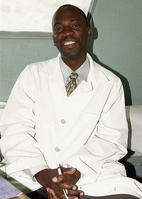Avia Collinder, Outlook Writer
Dr. Junior Taylor of the National Chest Hospital. -ColinHamilton/Freelance Photographer
TABLOID stories and programmes on television have convinced us that plastic surgery has more to do with making the ugly look more beautiful than with saving lives.
However, this week, local plastic surgeon Dr. Junior Taylor tells us a different story, one in which we discover another side to this speciality which, he says, amounts to much more than cosmetic procedures.
The concept of reconstructive surgery relates to reshaping, rebuilding and restoring, notes Dr. Taylor - a surgeon based at the National Chest Hospital in St. Andrew.
"Most people are aware of the cosmetic side of surgery. The specialisation, however, would be properly described as plastic and reconstructive surgery. The word plastic comes from the Greek word plasticus, which means to mould or to shape."
Plastics are versatile products and in the same way, plastic surgeons work in all areas of the body, all age groups and all conditions.
A plastic surgeon's work begins with the very young who suffer from congenital problems, including deformities to the face - cleft lips and palates - as well as deformed limbs, especially hands and feet.
Skin disorders
There are also deformities of the skin and skin disorders which need surgical attention.
Other cases include the treatment of trauma from burns and motor vehicle accidents. The doctors also find lots of work from a high level of violence. Where there is loss of tissue due to sharp instruments, gunshot wounds and other assaults, their special skills are called upon.
Another area of work involves treating scars, such as keloids. This is a condition mainly affecting pigmented skin which tends not to form scars as satisfactorily as Caucasian skin. Keloids are not merely a cosmetic issue, notes Dr. Taylor.
"If not addressed, they often cause pain, itching and discomfort. They may also develop in locations where they cause other difficulties," he notes.
Plastic surgeons also treat surgical incisions which have not healed properly.They also get involved in treating skin cancers.
Dr. Taylor explains, "We are the primary surgeons who examine, remove and reconstruct in collaboration with other surgeons - urological, neurosurgeons, ear, nose and throat specialists and orthopaedic surgeons."
Plastic surgeons are also occupied in the public health system with treating chronic wounds, including leg ulcers, pressure sores and any other wound which is slow to heal.
In some cases the surgeon is able to close the wound directly. If the wound cannot be closed, or if it is too wide, the plastic surgeon will use techniques including skin grafting - a thin shave of skin taken from one area and transferred to another - where it is needed. The skin will regenerate in the healthy area from which it is taken.
Reconstruction is another application involving the use of skin and subcutaneous tissue, including muscle and bone. These tissues are called flaps.
"We transfer this tissue from an adjacent or distant area into the defect created by the trauma or surgery," the plastic surgeon explains. "We also reconstruct tiny blood vessels in areas where these are needed to normalise blood supply."
Plastic surgeons also replace missing bones.
Next week. Breast surgery and burns caused by crime. Information provided by Dr. Junior Taylor, plastic surgeon based at the National Chest Hospital in St. Andrew.

